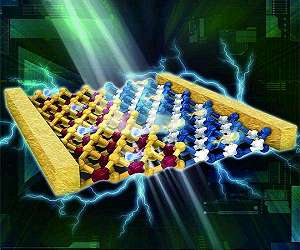Increasing the power conversion efficiency of solar cells is important for two reasons. In the long run, it is the most effective way to reduce the levelized cost of electricity. In the short term, it is the best way to promote photovoltaics for applications where space is limited e.g., roofs, facades, vehicles, or even drones.
However, all solar cells are fundamentally limited by the materials they are made from, which in turn affects the efficiencies they can achieve. The most adopted solar cell technologies to date are made with silicon. But despite silicon’s success, it has a theoretical efficiency limit of around 29%. Current efficiencies for this technology stand slightly below 27%, leaving a very small margin for future efficiency gains.
In the innovative race to exceed this limitation, scientists have added one (or more) complementary solar cell(s) to silicon to form “tandem” solar cells. The higher-energy visible light of the sun is absorbed in the top cell, while the lower-energy infrared light is absorbed in the silicon cell placed at the rear of the tandem. Halide perovskites have been identified as an ideal partner for silicon, as they can convert visible light more efficiently to electrical power in comparison to silicon alone, without overly increasing fabrication costs.
Double World Record Success
“We have passed a psychological barrier,” says Christophe Ballif, Head of the EPFL Photovoltaics Laboratory and CSEM’s Sustainable Energy Center.
“We have validated experimentally the high-efficiency potential of perovskite-on-silicon tandems. The 30% efficiency mark had already been achieved with other types of materials, namely III-V semiconductors.
“However, these materials and the processes used to make them are too expensive to sustain the energy transition – these devices are a thousand times more expensive than silicon solar cells. Our results are the first to show that the 30% barrier can be overcome using low-cost materials and processes, which should open new perspectives for the future of PV,” Ballif enthuses.
The researchers from Neuchatel have succeeded in improving the efficiency of two kinds of perovskite-on-silicon tandems. Firstly, they adapted materials and fabrication techniques to deposit high-quality perovskite layers from solution on a planarized silicon surface, reaching a power conversion efficiency of 30.93% for a 1 cm2 solar cell.
Secondly, by working on a new version of a hybrid vapor/solution processing technique compatible with textured silicon surfaces, they have produced a solar cell with a power conversion efficiency of 31.25% (again on 1 cm2). These results constitute two new world records: one for the planar and one for the textured device architecture.
The latter approach provides a higher current and is compatible with the structure of current industrial silicon solar cells. The previous efficiency conversion record for perovskite-on-silicon tandem solar cells was set in 2021 by a team at the Helmholtz Zentrum Berlin, who achieved 29.8%. EPFL’s and CSEM’s new records were independently certified by the National Renewable Energy Laboratory (NREL) in the United States.
Bright Future Ahead
“These high-efficiency results will now require further R and D to allow their scaling up onto larger surface areas and to ensure that these new cells can maintain a stable power output on our rooftops and elsewhere over a standard lifetime,” notes Quentin Jeangros of CSEM.
“Tandem perovskite-on-silicon technologies have been said to have the potential to exceed the 30% efficiency benchmark, but this is the first time this long-predicted potential has been demonstrated, which should hopefully pave the way for even cheaper sustainable electricity in the future,” concludes Christian Wolff of EPFL.
This research was driven by the EPFL PV-lab team in Neuchatel (Dr. Xin Yu Chin, Deniz Turkay, Kerem Artuk, Dr. Mathieu Boccard, and colleagues of the Tandem Photovoltaics team led by Dr. Christian Wolff), working in association with scientists at CSEM (Dr. Brett Kamino, Dr. Florent Sahli, Dr. Soo-Jin Moon, Arnaud Walter, and colleagues, led by Dr. Quentin Jeangros). It has received funding from the Swiss Federal Office of Energy, the Swiss National Science Foundation, the European Commission, the Services Industriels de Geneve, and the Advanced Manufacturing Initiative of the ETH domain.
Related Links
Swiss Federal Institute of Technology Lausanne
All About Solar Energy at SolarDaily.com
|
We need your help. The SpaceDaily news network continues to grow but revenues have never been harder to maintain. With the rise of Ad Blockers, and Facebook – our traditional revenue sources via quality network advertising continues to decline. And unlike so many other news sites, we don’t have a paywall – with those annoying usernames and passwords. Our news coverage takes time and effort to publish 365 days a year. If you find our news sites informative and useful then please consider becoming a regular supporter or for now make a one off contribution. |
||
|
SpaceDaily Contributor $5 Billed Once credit card or paypal |
SpaceDaily Monthly Supporter $5 Billed Monthly paypal only |
|

![]()
The structure-performance of bulk-heterojunction organic solar cells
Beijing, China (SPX) Jul 06, 2022
The active layer morphology of organic solar cells (OSCs) serves as the bridge that connects material properties with device performances, and thus the morphology is of critical importance in device fabrication. State-of-the-art power conversion efficiencies (PCEs) of OSCs based on p-type donor polymers and n-type non-fullerene acceptors (NFAs) forming multi-length-scale fibril interpenetrating networks are above 19% (Nature Materials, 2022, DOI:10.1038/s41563-022-01244-y). Such a morphology, composed o … read more
